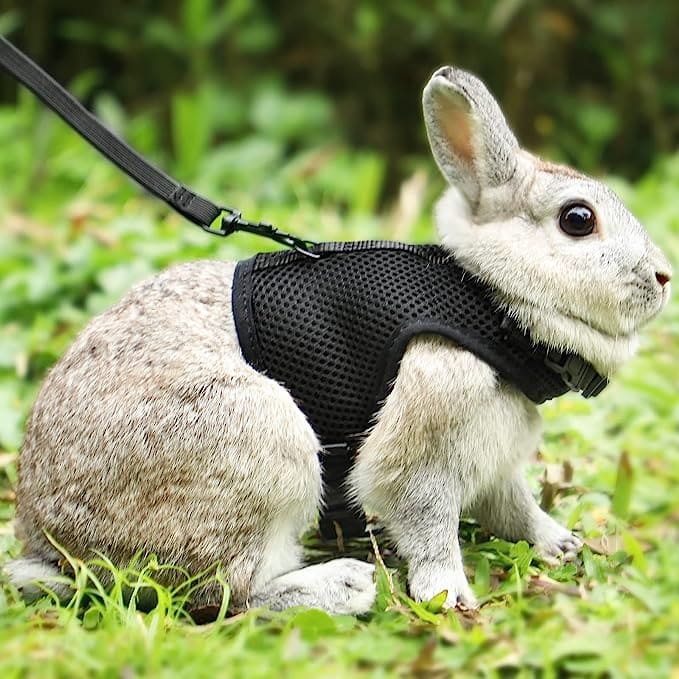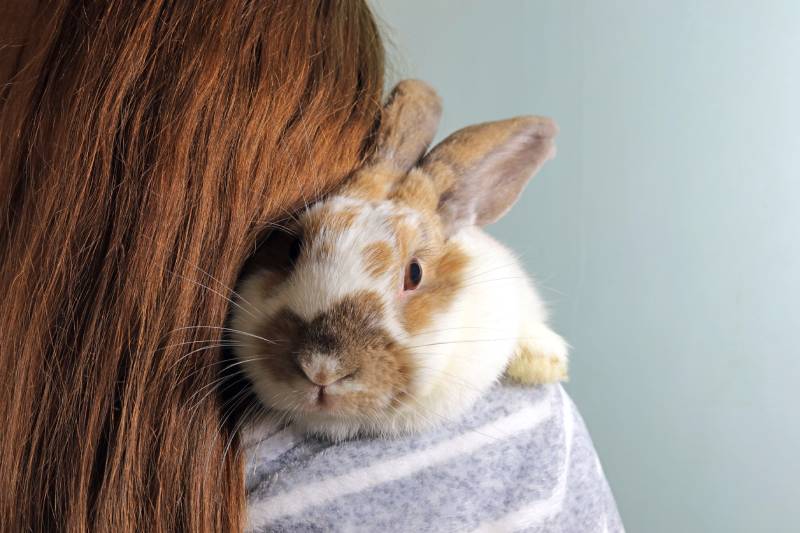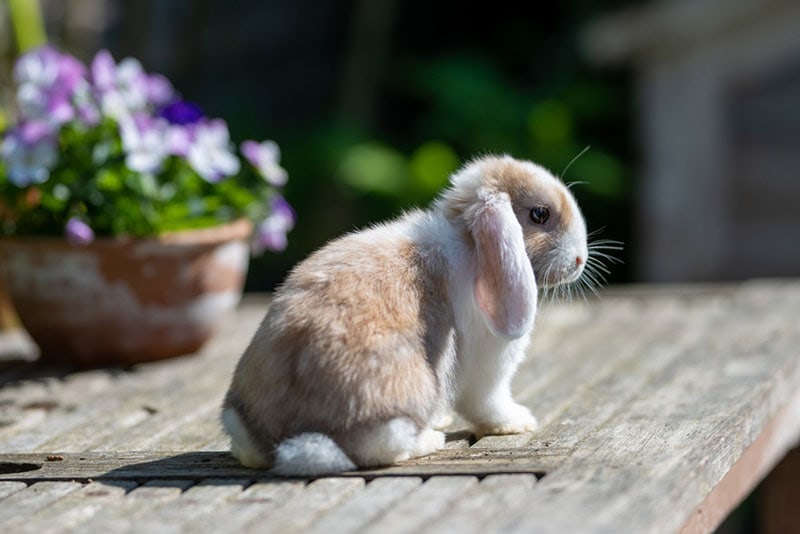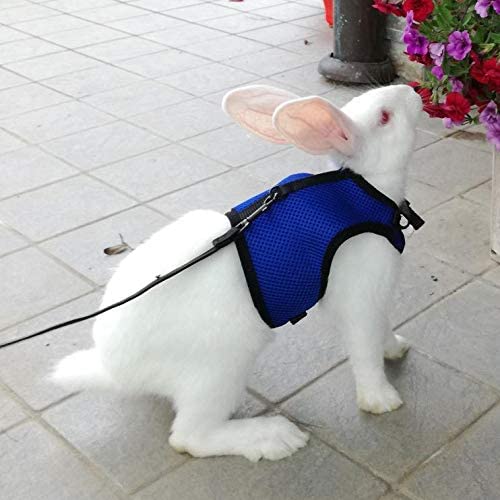
Click to Skip Ahead
When considering getting a pet, a dog or cat typically comes to mind; however, rabbits make wonderful pets and have adorable personalities! Rabbits are playful, loving, energetic, and quirky, all of which make them a fun pet to own.
Rabbits are intelligent enough to teach how to use a litter box, fetch, or come when called, but what about leash training a rabbit? Can it be done? Fortunately, with patience, you can leash-train your rabbit. In this post, we’ll list seven easy steps on how to leash-train your rabbit successfully.
Before You Start
A key point to remember is that leash training a rabbit is far different from leash training a dog. Dogs walk beside you on a leash and go where you go; however, this is not the case with rabbits. When you leash train a rabbit, don’t expect your rabbit to hop along beside you. Instead, your rabbit will be able to explore with you holding the leash with you following your rabbit.
Positive reinforcement is the best way to leash-train a rabbit. They are prey animals and are always on high alert and cautious. Positive reinforcement provides a desired consequence from the rabbit’s perspective for each step of the process, and they respond well to treats while training.
Leash training should only be done if your rabbit has a calm demeanor and enjoys learning new things—if your rabbit stresses easily, you should not attempt to leash train.
Preparation
Now that you’ve decided to give leash training your rabbit a go, you must first select an appropriate harness. After all, harnesses for dogs will be slightly different for a rabbit.
Look for a soft harness in an “H” shape, meaning when you lay the harness flat, it will look like the letter “H.” The harness should have a quick-release button that attaches under the chest and around the neck (some have Velcro). The attachment for the leash should not be around the neck but rather attached to a ring on the harness along the back. The harness should also have adjustment capabilities to accommodate your rabbit as he grows.
Step-By-Step Guide for Leash Training a Rabbit
1. Earn Your Rabbit’s Trust
This first crucial step is an important and necessary part of the leash training process, and you should only proceed once you’ve earned your rabbit’s trust. Rabbits are social animals and will enjoy spending time with you once they have learned to trust you.
When you first bring your rabbit home, sit on the floor and do not make sudden movements. Allow your rabbit to hop around and investigate you. Eventually, your rabbit will learn not to be fearful of you and trust you. You can always provide yummy treats when your rabbit gets close to you.

2. Introduce the Harness and Leash
Once you’ve established trust, you can now proceed, but do it slowly and cautiously. You can’t expect your rabbit to be okay with slapping a harness on him and expecting him to act like it’s normal.
First, pick a time when your rabbit is calm and in the exploring mood. Lay the harness and leash out on the floor and allow your rabbit to check them out. Ideally, place them by your rabbit’s favorite toys and allow him to play with them and sniff them. He may want to chew on them, and that’s ok as long as he doesn’t tear anything up. When your rabbit shows interest in the harness and leash, reward with a treat.
3. Lay the Harness Across the Body
Once your rabbit has warmed up to the harness’s presence, it’s time to take it a little further, but do it slowly. Start by gently placing the harness on your rabbit’s body and speak to him in a calm and soothing voice. This step may take several sessions before your rabbit allows the harness to be on his body. Remember, patience, patience, and more patience.
4. Apply the Harness
- Our Recommendation:Pettom Bunny Rabbit Harness with Stretchy Leash
Only proceed to this step once your rabbit allows the harness to be laid across the body.
When you’re sure your rabbit is comfortable with the harness across his back, it’s time to apply the harness over the neck and shoulders, but don’t buckle the buckles just yet. Instead, assess your rabbit’s reaction. If he appears stressed, take the harness off. Keep in mind that this process may take many times before your rabbit is comfortable. If he seems okay with it, you can go ahead and fasten the buckles (or Velcro, depending on the harness).
When putting the harness on, ensure you do not fit it too tight or too loose—you don’t want it to be too snug where it’s uncomfortable, and you don’t want it too loose to where your rabbit can slip out.
5. Start Indoors
Now that the harness is on your rabbit, slowly attach the leash and observe his reaction. Remember to always abort the session if your rabbit is stressed. Once he seems comfortable, let your rabbit lead the way, but stay indoors first to ensure his safety. Remember, your rabbit will be walking you and not the other way around. Now, let your rabbit explore and follow behind.
6. Keep Training Sessions Short
As a rule, each training session should be limited to 15 minutes. You don’t want to stress your rabbit out, and always assess your rabbit’s demeanor during the training sessions. Abort the training if your rabbit seems nervous, agitated, or frightened.
End each session with a tasty reward and calm praise. Take heed not to feed too many treats each time, and you can always provide safe herbs, like cilantro and basil, for a healthy treat.
7. Let the Outdoor Adventures Begin!
Once your rabbit is completely comfortable hopping around indoors with the leash and harness, you can now try being outdoors. This is where it’s extremely important to have the harness fitted properly—you’ll need to be able to grab your rabbit should a threat arise.
It’s best to start out in your backyard or another area outdoors your rabbit is already familiar with. Once your rabbit is comfortable exploring the outdoors, you can continue rewarding him with treats, but don’t overdo it.

Additional Tips
Final Thoughts
We want to remind you to never force your rabbit to be in a harness, and never tug on the leash or expect your rabbit to sit or stay like a dog. Abandon all instincts you have from walking a dog and think like a rabbit instead. Rabbits are curious, and he’ll want to explore in bushes and other nooks and crannies.
Remember that your rabbit will be walking you instead of the other way around. Always stay behind your rabbit while exploring, and always be alert to potential dangers. Most of all, have fun letting your rabbit explore the big wide world safely.
Featured Image Credit: Amazon









